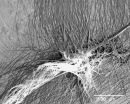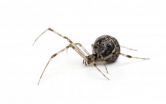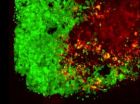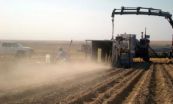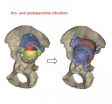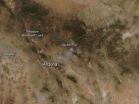(Press-News.org) Researchers at The University of Akron are again spinning inspiration from spider silk—this time to create more efficient and stronger commercial and biomedical adhesives that could, for example, potentially attach tendons to bones or bind fractures.
The Akron scientists created synthetic duplicates of the super-sticky, silk "attachment discs" that spiders use to attach their webs to surfaces. These discs are created when spiders pin down an underlying thread of silk with additional threads, like stiches or staples, explains Ali Dhinojwala, UA's H. A. Morton professor of polymer science and lead researcher on the project. This "staple-pin" geometry of the attachment disc creates a strong attachment force using little material, he adds.
Through electrospinning, a process by which an electrical charge is used to draw very fine fibers from a liquid (in this case, polyurethane), Dhinojwala and his team were able to mimic the efficient staple-pin design, pinning down an underlying nylon thread with the electrospun fibers.
"This adhesive architecture holds promise for potential applications in the area of adhesion science, particularly in the field of biomedicine where the cost of the materials is a significant constraint," the authors write in their paper, "Synthetic Adhesive Attachment Discs Inspired by Spider's Pyriform Silk Architecture," published online March 1 in the Journal of Polymer Physics.
Dhinojwala adds that the design could potentially be used, in addition to medical applications, to create commercial adhesives stronger than conventional glue and tape.
"Instead of using big globs of glue, for example, we can use this unique and efficient design of threads pinning down a fiber," he says. "The inspiration was right in front of us, in nature."
"You can learn a lot of science from nature," adds Dharamdeep Jain, graduate student and co-author of the paper.
Indeed, researchers at UA have been learning quite a bit from nature's silk-spinning artists.
Dhinojwala and Vasav Sahni, former graduate student and third co-author of the aforementioned paper, previously worked together to study the adhesive properties of spider silk; and last year Todd Blackledge, Leuchtag Endowed Chair and associate professor of biology and integrated bioscience at UA, revealed the possibilities of using silk to develop materials that are as strong as steel and yet flexible as rubber.
INFORMATION:
Spiders spin possible solution to 'sticky' problems
How to attach tendons to bones and build stronger adhesives? Stick with spider silk, UA researchers say
2014-05-16
ELSE PRESS RELEASES FROM THIS DATE:
With imprecise chips to the artificial brain
2014-05-16
This news release is available in German. Which circuits and chips are suitable for building artificial brains using the least possible amount of power? This is the question that Junior Professor Dr. Elisabetta Chicca from the Center of Excellence Cognitive Interaction Technology (CITEC) has been investigating in collaboration with colleagues from Italy and Switzerland.
Their surprising finding: Constructions that use not only digital but also analog compact and imprecise circuits are more suitable for building artificial nervous systems, rather than arrangements ...
Lighting the way to graphene-based devices
2014-05-16
Graphene continues to reign as the next potential superstar material for the electronics industry, a slimmer, stronger and much faster electron conductor than silicon. With no natural energy band-gap, however, graphene's superfast conductance can't be switched off, a serious drawback for transistors and other electronic devices. Various techniques have been deployed to overcome this problem with one of the most promising being the integration of ultrathin layers of graphene and boron nitride into two-dimensional heterostructures. As conductors, these bilayered hybrids ...
Herpes-loaded stem cells used to kill brain tumors
2014-05-16
Harvard Stem Cell Institute (HSCI) scientists at Massachusetts General Hospital have a potential solution for how to more effectively kill tumor cells using cancer-killing viruses. The investigators report that trapping virus-loaded stem cells in a gel and applying them to tumors significantly improved survival in mice with glioblastoma multiforme, the most common brain tumor in human adults and also the most difficult to treat.
The work, led by Khalid Shah, MS, PhD, an HSCI Principal Faculty member, is published in the Journal of the National Cancer Institute. Shah heads ...
Ataluren Phase 3 trial results in nonsense mutation cystic fibrosis
2014-05-16
SOUTH PLAINFIELD, NJ – May 16, 2014 – PTC Therapeutics, Inc. (NASDAQ: PTCT) today announced that the results of a Phase 3 study of ataluren in patients with nonsense mutation cystic fibrosis (nmCF) were published in Lancet Respiratory Medicine. The results demonstrated positive trends in both the primary endpoint, lung function as measured by relative change in % predicted FEV1 (forced expiratory volume in one second) and in the secondary outcome measure, rate of pulmonary exacerbations. The collective data from this trial, including retrospective and subgroup analyses ...
Glasses-free 3-D projector
2014-05-16
Over the past three years, researchers in the Camera Culture group at the MIT Media Lab have steadily refined a design for a glasses-free, multiperspective, 3-D video screen, which they hope could provide a cheaper, more practical alternative to holographic video in the short term.
Now they've designed a projector that exploits the same technology, which they'll unveil at this year's Siggraph, the major conference in computer graphics. The projector can also improve the resolution and contrast of conventional video, which could make it an attractive transitional technology ...
Growing camelina and safflower in the Pacific Northwest
2014-05-16
A recent study published in Agronomy Journal provides information important to farmers growing oilseed crops. In the study, camelina and safflower were grown in three-year rotations with winter wheat and summer fallow. The study shows that using this rotation may require that no tillage should be done to the soil during the fallow year. Oilseed crops produce relatively little residue—organic material such as roots that hold the soil together. Even light tillage can disintegrate the soil.
A cooperative study by the USDA-ARS and Washington State University researched the ...
How Asian American 'tiger mothers' motivate their children
2014-05-16
An article titled "Why Chinese Mothers Are Superior," published in The Wall Street Journal in 2011, has continued to provoke a cultural debate among parents after self-proclaimed 'tiger mother' Amy Chua asserted that Asian American parenting methods produce more successful children. Researchers at Stanford University delved deeper into Chua's 'tiger mother' approach, and their research sheds light on key fundamental differences in parenting methods between Asian Americans and European Americans.
To reveal the cultural differences in parenting, the researchers compare ...
Ground breaking hip and stem cell surgery in Southampton
2014-05-16
Doctors and scientists in Southampton have completed their first hip surgery with a 3D printed implant and bone stem cell graft.
The 3D printed hip, made from titanium, was designed using the patient's CT scan and CAD CAM (computer aided design and computer aided manufacturing) technology, meaning it was designed to the patient's exact specifications and measurements.
The implant will provide a new socket for the ball of the femur bone to enter. Behind the implant and between the pelvis, doctors have inserted a graft containing bone stem cells.
The graft acts as ...
Fires continue in San Diego County, California
2014-05-16
Seven fires are still burning in San Diego County, California. Arson is suspected as the origin of these fires. Two teens have been arrested on suspicion of setting the fire that spread so ferociously across the county. All of California is experiencing exceptional, extreme or severe drought conditions. The wildfire area is in the second-most dangerous category--extreme drought conditions. California's governor has cited climate change as a factor in the fires, noting the last three years have been the driest in recorded history. Wildfire season used to start in late ...
Skunk fire in Arizona
2014-05-16
The Skunk Fire in Arizona started with a lightning strike on Saturday, April 19. Currently over 10,000 acres have been affected. It is located in the San Carlos Apache Reservation. The terrain in the area is very steep with boulders making it difficult for firefighters to traverse the area to fight the fire. The fire continues to grow to the north, but fire activity in the south has been stopped. The fire is currently 20% contained.
The National Weather Service is forecasting winds of 7-12 mph with gusting to 25 mph. These conditions coupled with extremely dry fuels ...
LAST 30 PRESS RELEASES:
New software sheds light on cancer’s hidden genetic networks
UT Health San Antonio awarded $3 million in CPRIT grants to bolster cancer research and prevention efforts in South Texas
Third symposium spotlights global challenge of new contaminants in China’s fight against pollution
From straw to soil harmony: International team reveals how biochar supercharges carbon-smart farming
Myeloma: How AI is redrawing the map of cancer care
Manhattan E. Charurat, Ph.D., MHS invested as the Homer and Martha Gudelsky Distinguished Professor in Medicine at the University of Maryland School of Medicine
Insilico Medicine’s Pharma.AI Q4 Winter Launch Recap: Revolutionizing drug discovery with cutting-edge AI innovations, accelerating the path to pharmaceutical superintelligence
Nanoplastics have diet-dependent impacts on digestive system health
Brain neuron death occurs throughout life and increases with age, a natural human protein drug may halt neuron death in Alzheimer’s disease
SPIE and CLP announce the recipients of the 2025 Advanced Photonics Young Innovator Award
Lessons from the Caldor Fire’s Christmas Valley ‘Miracle’
Ant societies rose by trading individual protection for collective power
Research reveals how ancient viral DNA shapes early embryonic development
A molecular gatekeeper that controls protein synthesis
New ‘cloaking device’ concept to shield sensitive tech from magnetic fields
Researchers show impact of mountain building and climate change on alpine biodiversity
Study models the transition from Neanderthals to modern humans in Europe
University of Phoenix College of Doctoral Studies releases white paper on AI-driven skilling to reduce burnout and restore worker autonomy
AIs fail at the game of visual “telephone”
The levers for a sustainable food system
Potential changes in US homelessness by ending federal support for housing first programs
Vulnerability of large language models to prompt injection when providing medical advice
Researchers develop new system for high-energy-density, long-life, multi-electron transfer bromine-based flow batteries
Ending federal support for housing first programs could increase U.S. homelessness by 5% in one year, new JAMA study finds
New research uncovers molecular ‘safety switch’ shielding cancers from immune attack
Bacteria resisting viral infection can still sink carbon to ocean floor
Younger biological age may increase depression risk in older women during COVID-19
Bharat Innovates 2026 National Basecamp Showcases India’s Most Promising Deep-Tech Ventures
Here’s what determines whether your income level rises or falls
SCIE indexation achievement: Celebrate with Space: Science & Technology
[Press-News.org] Spiders spin possible solution to 'sticky' problemsHow to attach tendons to bones and build stronger adhesives? Stick with spider silk, UA researchers say
